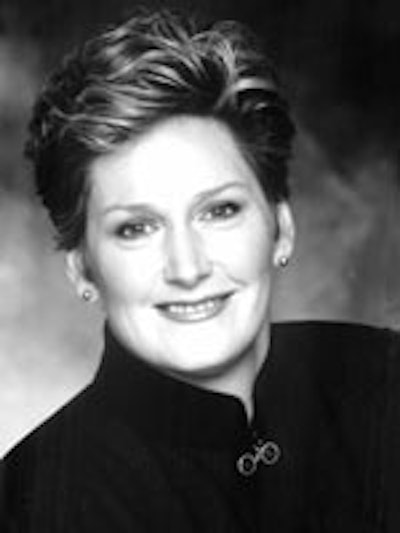
Cathy Brown has spent more than 10 years as president of Children Affected by AIDS Foundation (CAAF), and for her, October always seems to be particularly busy. From her base in Los Angeles, Brown oversees the foundation's annual Dream Halloween event, a production-heavy affair that brings family activities set in a Trick or Treat village to three American cities. This year, the event comes to Chicago's Windy City Fieldhouse on October 18, New York's Roseland Ballroom the next day, and Barker Hangar in Los Angeles on October 25. The event is expected to draw 1,200, 700, and 2,200 guests, respectively.
Along with planning the three-city event, Brown spent the past year facilitating a surrounding campaign, which launched October 1. The campaign aims to raise funds and awareness for CAAF and features everything from specially designed Dream Halloween costumes to an interactive e-card available on the CAAF Web site and a promotional video starring Jamie Lee Curtis. We recently spoke with Brown about these efforts, building relationships with corporate sponsors, and working at a nonprofit in the current economy.
Give us some background on Dream Halloween.
Halloween is the second largest retail holiday, and it's a time of fun and celebration for both children and adults. Fifteen years ago, CAAF decided to capitalize on this and celebrate Halloween in a fashion that would also enable us to raise funds. This last year, we have expanded the event into a full-blown campaign that involves corporate partners, a Halloween e-card, and a text-message campaign.
Tell us about some of those corporate sponsors and the roles they play in each city.
Toys R Us and Mattel have sponsored this event since its inception [in 1993]. Toys R Us has been the presenting sponsor in New York for the past two years, and will act as the presenting sponsor in Chicago for the first time this year. Nickelodeon is also one of the founding sponsors of the New York event. Disney is another long-standing sponsor, and has supported us for 15 years. Disney and Toys R Us developed the special Dream Halloween costumes, which are sold in Toys R Us stores and help raise funds for CAAF and bring awareness to the campaign. At this year's Chicago event, we're honoring Resnick Automotive Group because they have given us a car to auction for the past nine years. American Airlines has been our official airline all year long, and they're helping us with the auctions.
Our relationship with each of our sponsors has really become a meaningful exchange, where they're not only giving something to us, but we're giving something back. We show them what we're doing to change the lives of children affected by AIDS and how their partnership helps us in those efforts. In turn, we can help them with corporate outreach and philanthropy efforts.
What kind of auctions will take place this year?
We have silent auctions in all three cities, and we've had to make sure to structure them extremely well in this economy. This means bundling items to make them more attractive to donors. Instead of just a dinner, for instance, you add a hotel stay and make a weekend out of the package. We have live auctions in Chicago and Los Angeles, and this year people will be able to sponsor activities for children for the first time. Our new texting campaign allows people to donate by texting the word dream to a certain number.
CAAF also has a promotional video on Facebook and MySpace that stars Jamie Lee Curtis. How do you measure the results?
We have a tracking system to measure how much is coming in through online donations, and we measure an event's success through money raised and surrounding publicity. The texting campaign is brand new—and, I might add, it cost very little to set up. Whatever amount we raise from the texting campaign will be new revenue.
Which promotional tool has proven the most effective in raising funds or awareness?
At the moment, we're still measuring the results. Some we won't know until after the events have taken place, but we do know that the Jamie Lee Curtis video has been picked up very widely.
How effective is it to have a celebrity's name attached to a fund-raiser?
Celebrity involvement makes a tremendous impact. Jamie Lee Curtis has been our national spokesperson for 11 years, and we have several other celebrities that have supported us. They're so open to greeting guests and spending time with our donors—Jamie Lee Curtis has even hosted cocktail parties for our top-level sponsors. For the past seven years, Chris Meloni from Law and Order: Special Victims Unit and his wife, Sherman, have helped out with our New York City event. Melina Kanakaredes from CSI: NY has helped us in Chicago. This year, one of the stars of Gossip Girl [Leighton Meester] is coming to our New York event, so we know that will help us get lots of press. So there's no question that celebrity involvement helps call attention to a charity and helps with outreach and attracting donors.
How do you think the current economic situation will affect planning for next year?
To be better prepared, we'll have to move all planning efforts up by one quarter. November is our wrap-up month [for the current year's event], and we approach top-level donors in January. Usually, we wait until April to start approaching mid-level donors, but next year our proposals will go out in February or March. We'll also look to our treasurer and board of directors to help us with forecasting, and they'll find out what next year will look like.
As a fellow in the American Society of Association Executives and the Center for Association Leadership, you help identify best practices and cutting-edge thinking for nonprofits. What are some of the techniques planners can employ, in light of the financial crisis?
Planners will need to take advantage of social networking, and really use it as a vehicle for raising funds and awareness. It's important to stress partnerships in this kind of climate. Also, make sure that your relationships with corporate partners are two-way, so that you're not just asking your partners to write checks. Leadership will have to be realistic and have programmatic plans in place for next year. Also, keep in mind that it's an election year. Next year, fund-raising for the election will be over, but there will be a change of administration. And regardless of which that administration is, there will be a new political climate, and the resulting policies and programs will take a while to fall into place. Planners will have to look at what that new administration will be doing policy-wise.



















